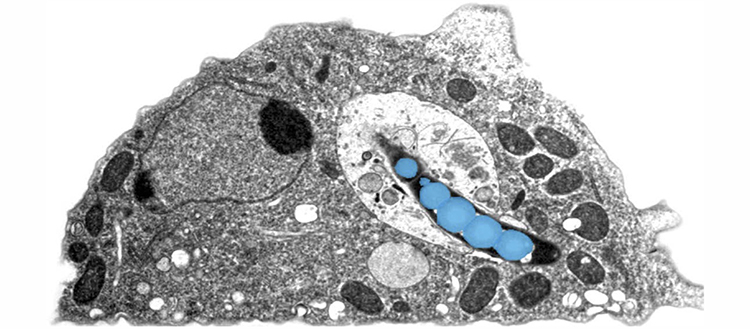Amoebas to replace laboratory mice
The University of Geneva awards its 3R Prize to research that reduces the number of animals in experimentation through better selection of the compounds to be tested.

Electron microscopy photograph of an amoeba infected with mycobacteria (coloured blue for easy viewing). © UNIGE
Minimize the number of anti-infective compounds to be tested in an animal model by first selecting them on infected amoebas to retain only the most effective ones. This is the aim of the research published in 2018 in the journal Scientific Report and awarded this autumn with the 3R Prize from the University of Geneva (UNIGE). This prize has been awarded since 2016 to a UNIGE researcher for his or her contribution to the 3Rs. The 3R principles –to “reduce”, “refine”, “replace”– aim to reduce the number of animals used in experiments, to refine the methodology to minimize the constraints on the animal while improving the quality of the results obtained, and to replace the animal model with alternative methods as soon as possible.
By developing a technique to test anti-infective compounds on infected amoebas in order to retain only the most effective ones, the group of Thierry Soldati, Associate Professor in the Department of Biochemistry at the Faculty of Science of the UNIGE, makes it possible to considerably reduce the number of tests that will then have to be carried out on the mouse. Their research meets the criteria of the 3R policy “which has established itself as the international ethical standard in animal experimentation,” says Marjolaine Philit, Director of Animal Experimentation at UNIGE.
The first line of defence of our immune system is made up of macrophage cells, a variety of white blood cells, capable of distinguishing between what belongs to the body and what is foreign in order to eliminate it. But in the case of an infection like tuberculosis, these macrophages cannot complete their work and eliminate the bacteria. We must therefore help them by using antibiotics. The global pharmacopoeia of antibiotics against the tuberculosis bacillus is increasingly being thwarted by the emergence of resistant bacteria. The answer therefore lies in the development of new chemical, synthetic or natural compounds. To select antibiotics, the pharmaceutical industry tests their effectiveness directly on the tuberculosis bacteria, but the vast majority of these compounds fail when research continues on infected cells or animals, because the bacteria do not behave in the same way.
The challenge is therefore to eliminate as quickly as possible those compounds that do not cure infection in animals, and for this purpose, the group of Thierry Soldati has set up a compound selection system that acts as a filter and reliably predicts which compounds will be the best anti-infectives. “We used a sample of 180 compounds provided by GlaxoSmithKline, all effective against the bacteria that cause tuberculosis”, says Thierry Soldati. But instead of using them on the bacteria, the research team used amoebas, which are unicellular beings from forest soils that behave in a way comparable to our macrophages. The macrophages use the same “tools” as amoebas to identify and kill a bacterium, and both can be infected with tuberculosis bacteria, hence the relevance of this model system. “Using an infected amoeba is a simple technique that has been used by researchers for about 15 years. Our latest publications show that they can be used to select anti-infective chemicals”, he explains. It is therefore a high-performance model, and this is what the 3R price reaffirms.
“We were able to show that only 5% of the chemical compounds effective against the bacteria continued to give results on the infected amoebas and remain eligible for the next phase, testing on infected animals. Thanks to this much finer selection of new compounds, Thierry Soldati’s team is able to reduce by a factor of 10 to 100 the number of individuals required during the transition to animal experimentation. Without this research, hundreds of compounds would be tested on mice that would have had little chance of being effective.
“Our research is now focused on the selection of natural compounds that are often found in medicinal plants used in traditional medicines, in Africa or elsewhere. We can thus combine 3R techniques with the use of the amoeba model, pharmaceutical sciences to isolate the compounds to be tested, and ancestral knowledge, to develop new classes of anti-infective compounds!” concludes Thierry Soldati.
